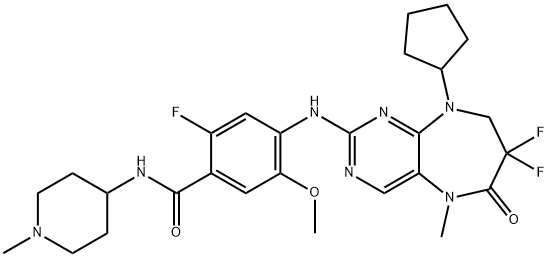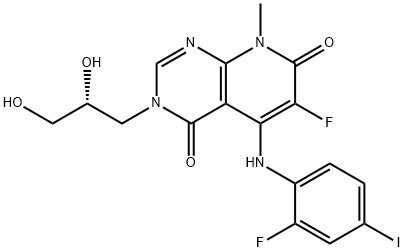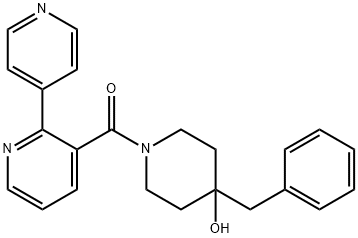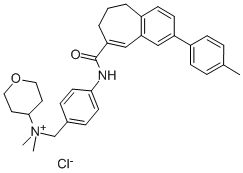TAK-960
- CAS NO.:1137868-52-0
- Empirical Formula: C27H34F3N7O3
- Molecular Weight: 561.6
- MDL number: MFCD22420821
- SAFETY DATA SHEET (SDS)
- Update Date: 2024-11-15 21:27:52

What is TAK-960?
The Uses of TAK-960
TAK-960 is a potent and selective inhibitor of polo-like kinase 1 (PLK1), a serine/threonine protein kinase involved in key processes during mitosis. TAK-960 has shown activity in several tumor cell l ines, including those that express multidrug-resistant protein 1 (MDR1). TAK-960 treatments has shown significant efficacy against multiple tumor xenografts and is a potential chemotherapeutic agent f or patients with advanced tumors.
The Uses of TAK-960
TAK-960 is a potent and selective inhibitor of polo-like kinase 1 (PLK1), a serine/threonine protein kinase involved in key processes during mitosis. TAK-960 has shown activity in several tumor cell lines, including those that express multidrug-resistant protein 1 (MDR1). TAK-960 treatments has shown significant efficacy against multiple tumor xenografts and is a potential chemotherapeutic agent for patients with advanced tumors.
What are the applications of Application
TAK-960 is a Plk inhibitor
Biological Activity
polo-like kinase 1 (plk1) is a serine/threonine protein kinase involved in key mitosis processes. human plk1 has been shown to be overexpressed in various human cancers. elevated levels of plk1 have been associated with poor prognosis, making it an attractive target for anticancer therapy. tak-960 is a novel, investigational, orally bioavailable, potent, and selective plk1 inhibitor.
in vitro
tak-960 treatment caused accumulation of g2–m cells, aberrant polo mitosis morphology, and increased the phosphorylation of histone h3. tak-960 inhibited proliferation of multiple cancer cell lines, with mean ec50 ranging from 8.4 to 46.9 nmol/l, but not in nondividing normal cells [1].
in vivo
in animal models, oral administration of tak-960 increased phh3 in a dose-dependent manner and significantly inhibited the growth of ht-29 colorectal cancer xenografts. once daily treatment tak-960 exhibited significant efficacy against multiple tumor xenografts, including an adriamycin/paclitaxel-resistant xenograft model and a disseminated leukemia model [1].
References
[1] hikichi y, honda k, hikami k, miyashita h, kaieda i, murai s, uchiyama n, hasegawa m, kawamoto t, sato t, ichikawa t, cao s, nie z, zhang l, yang j, kuida k, kupperman e. tak-960, a novel, orally available, selective inhibitor of polo-like kinase 1, shows broad-spectrum preclinical antitumor activity in multiple dosing regimens. mol cancer ther. 2012 mar;11(3):700-9.
[2]
[3]
Properties of TAK-960
| Density | 1.39±0.1 g/cm3(Predicted) |
| storage temp. | Store at -20°C |
| solubility | ≥28.05 mg/mL in DMSO; insoluble in H2O; ≥12.3 mg/mL in EtOH |
| form | solid |
| pka | 13.21±0.20(Predicted) |
| color | White to light yellow |
Safety information for TAK-960
Computed Descriptors for TAK-960
New Products
4-Fluorophenylacetic acid 4-Methylphenylacetic acid N-Boc-D-alaninol N-BOC-D/L-ALANINOL Tert-butyl bis(2-chloroethyl)carbamate 3-Morpholino-1-(4-nitrophenyl)-5,6-dihydropyridin- 2(1H)-one Furan-2,5-Dicarboxylic Acid Tropic acid S-2-CHLORO PROPIONIC ACID ETHYL ISOCYANOACETATE 2-Bromo-1,3-Bis(Dimethylamino)Trimethinium Hexafluorophosphate (6-METHYL-[1,3]DITHIOLO[4,5-b]QUINOXALIN-2-ONE INDAZOLE-3-CARBOXYLIC ACID 4-IODO BENZOIC ACID (2-Hydroxyphenyl)acetonitrile 4-Bromopyrazole 5,6-Dimethoxyindanone 2-(Cyanocyclohexyl)acetic acid 4-methoxy-3,5-dinitropyridine 2-aminopropyl benzoate hydrochloride 1-(4-(aminomethyl)benzyl)urea hydrochloride diethyl 2-(2-((tertbutoxycarbonyl)amino) ethyl)malonate tert-butyl 4- (ureidomethyl)benzylcarbamate Ethyl-2-chloro((4-methoxyphenyl)hydrazono)acetateRelated products of tetrahydrofuran

![6-[(7S)-7-Hydroxy-6,7-dihydro-5H-pyrrolo[1,2-c]imidazol-7-yl]-N-methyl-2-naphthalenecarboxamide](https://img.chemicalbook.in/CAS/GIF/566939-85-3.gif)
![Benzoic acid, 4-[[(cyclopropylmethyl)[4-(2-fluorophenoxy)benzoyl]amino]methyl]-](https://img.chemicalbook.in/CAS/20200515/GIF/1664335-55-0.gif)





You may like
-
 Tak-960 95% CAS 1137868-52-0View Details
Tak-960 95% CAS 1137868-52-0View Details
1137868-52-0 -
 2033-24-1 98%View Details
2033-24-1 98%View Details
2033-24-1 -
 1975-50-4 98%View Details
1975-50-4 98%View Details
1975-50-4 -
 2-HYDROXY BENZYL ALCOHOL 98%View Details
2-HYDROXY BENZYL ALCOHOL 98%View Details
90-01-7 -
 2-Chloro-1,3-Bis(Dimethylamino)Trimethinium Hexafluorophosphate 221615-75-4 98%View Details
2-Chloro-1,3-Bis(Dimethylamino)Trimethinium Hexafluorophosphate 221615-75-4 98%View Details
221615-75-4 -
 61397-56-6 CIS BROMO BENZOATE 98%View Details
61397-56-6 CIS BROMO BENZOATE 98%View Details
61397-56-6 -
 14714-50-2 (2-Hydroxyphenyl)acetonitrile 98+View Details
14714-50-2 (2-Hydroxyphenyl)acetonitrile 98+View Details
14714-50-2 -
 118753-70-1 98+View Details
118753-70-1 98+View Details
118753-70-1